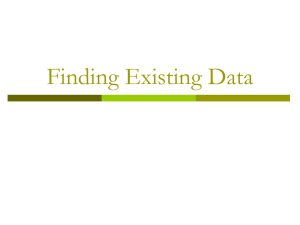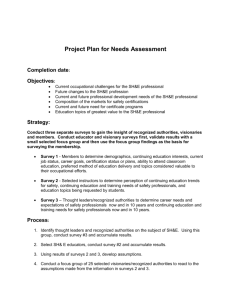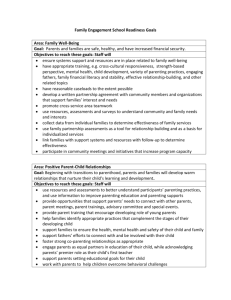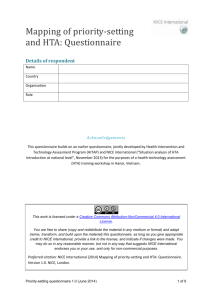Needs Assessment by John Arango - National Legal Aid & Defender
advertisement
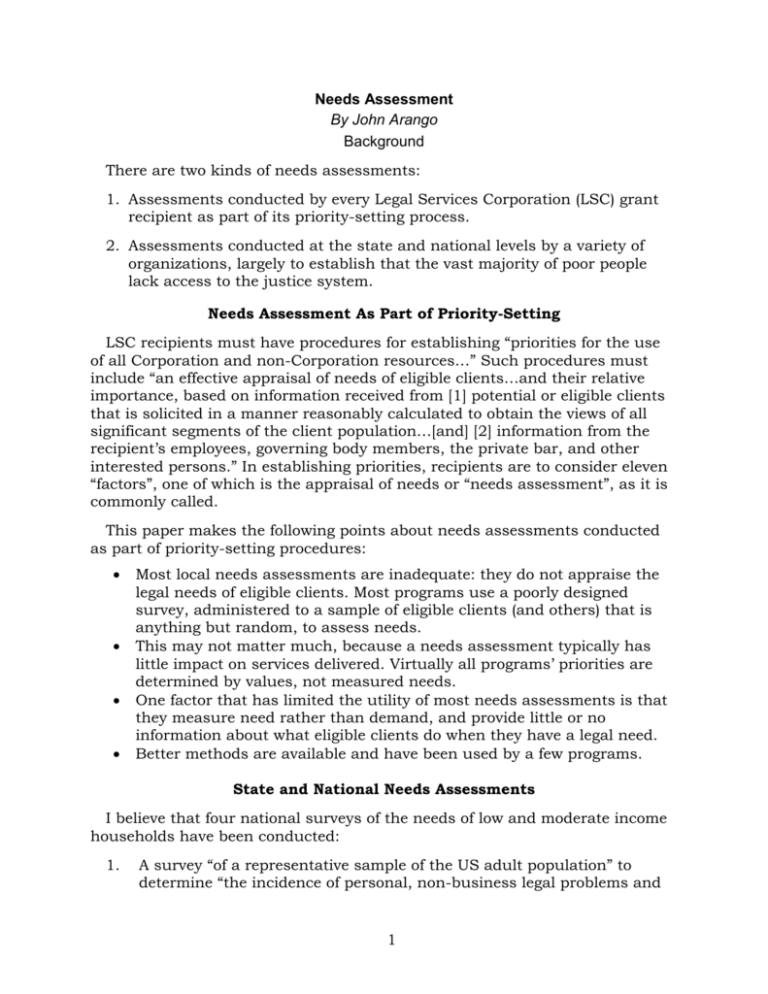
Needs Assessment By John Arango Background There are two kinds of needs assessments: 1. Assessments conducted by every Legal Services Corporation (LSC) grant recipient as part of its priority-setting process. 2. Assessments conducted at the state and national levels by a variety of organizations, largely to establish that the vast majority of poor people lack access to the justice system. Needs Assessment As Part of Priority-Setting LSC recipients must have procedures for establishing “priorities for the use of all Corporation and non-Corporation resources…” Such procedures must include “an effective appraisal of needs of eligible clients…and their relative importance, based on information received from [1] potential or eligible clients that is solicited in a manner reasonably calculated to obtain the views of all significant segments of the client population…[and] [2] information from the recipient’s employees, governing body members, the private bar, and other interested persons.” In establishing priorities, recipients are to consider eleven “factors”, one of which is the appraisal of needs or “needs assessment”, as it is commonly called. This paper makes the following points about needs assessments conducted as part of priority-setting procedures: Most local needs assessments are inadequate: they do not appraise the legal needs of eligible clients. Most programs use a poorly designed survey, administered to a sample of eligible clients (and others) that is anything but random, to assess needs. This may not matter much, because a needs assessment typically has little impact on services delivered. Virtually all programs’ priorities are determined by values, not measured needs. One factor that has limited the utility of most needs assessments is that they measure need rather than demand, and provide little or no information about what eligible clients do when they have a legal need. Better methods are available and have been used by a few programs. State and National Needs Assessments I believe that four national surveys of the needs of low and moderate income households have been conducted: 1. A survey “of a representative sample of the US adult population” to determine “the incidence of personal, non-business legal problems and 1 2. 3. 4. the use of legal services for their resolution” conducted by Barbara Curran for the American Bar Association in 1974. This survey was the source of the fact that about 20% of low income households with a legal need receive some kind of assistance from a lawyer. (This figure has been widely misinterpreted to mean that the 20% receive assistance from a legal services program. The Comprehensive Legal Needs Study (see below) showed that the correct figure is closer to 8%, although, because of differing levels of state funding, there is a wide spread around this figure from state to state. The unaccounted for 12% is provided by the private bar, often for a fee). A follow-up to that survey, also conducted by Barbara Curran, in 1989, for the ABA’s Consortium on Legal Services and the Public, in preparation for the Access to Justice in the 1990’s Conference held in New Orleans in June, 1989. A “limited, random national telephone survey of households at or below 125% of poverty to determine current civil legal needs” conducted by the Spangenberg Group in November-December, 1988, for the same conference. The Comprehensive Legal Needs Study, also sponsored by the ABA Consortium. One part of the study was a survey of legal needs of low and moderate income families conducted by the Institute for Survey Research at Temple University in February-June, 1993. State surveys have been more common. I believe the first state survey was conducted in Alabama in the late 1970’s. It probably contains the best data on legal needs in the rural south, since information was collected in face-to-face interviews of a randomly selected group of low income households. Since then, many states have conducted needs assessments. The Spangenberg Group did many of them in the 1980’s and early 1990’s. Probably the best surveys were conducted in Massachusetts, Connecticut, Georgia and Florida as an add-on to the ABA’s Comprehensive Legal Needs Study. The following points could be made about state and national surveys (but won’t be—in any detail—in order to keep the length of this paper under control): State surveys have had little direct impact on the delivery of services, for the same reason cited above: local priorities are determine by values rather than facts. State surveys have been exceptionally effective as a fund-raising tool and thus have had a major indirect impact on the delivery of services. Overall, programs and funders have paid too little attention to the ABA’s Comprehensive Legal Needs Study (and the state accompanying surveys), which, though old, contain information on 1) what low income households do when they have a legal needs, and 2) the role of the private bar in the delivery of legal assistance to poor people, that is unobtainable from any 2 other source and should have been taken into account by every state planning process. Needs Assessment as Part of Priority-Setting Early History Formal needs assessment was introduced to legal services by Planning Associates, a nonprofit management consulting firm under contract to the Technical Assistance Project of NLADA in the early 1970’s. After experiments in several programs around the country, Planning Assistance published a manual (Too Many Clients, Too Little Time) that programs could use to develop a planning procedure aimed at setting “priorities” for the delivery of services. Typically, needs (public benefits, housing, health, education, etc.) were assessed in a “green light” session at the beginning of a weekend retreat attended by eligible clients and program staff and board members. Often, more than 100 people participated. (The record, in my experience, was more than 300 at a retreat in Miami, conducted in English, Spanish and Creole). Participants then divided into small groups to develop strategies, goals and objectives for each area of need. Towards the end of the retreat, the projected goals, strategies and objectives were reported to the entire group. A “straw vote” was then held to give some sense of the group’s preferences. This was followed by a “lobbying session”, in which participants attempted to persuade members of the group to change their vote. A final vote was then held, and, after discussion and confirmation by the board of directors, the goals with the most votes became the program’s “priorities”. The retreat was followed by “implementation”, in which program staff matched priorities to resources and staff expertise and developed “worktasks” and schedules describing how the goals were to be achieved. The LSC issued “Regulation 1620-Priorities in the Use of Resources” in the late 1970’s. Before, during and after the adoption of the regulation, there was some controversy about how needs should be assessed. John McDonald, at first director of Legal Aid of Orange County and later director of the training unit at the LSC, maintained that the only way to assess needs was to conduct a survey in the client community. Others, though recognizing the value of a survey, argued that dialogue between eligible clients and staff was a critically important part of ranking needs, and a retreat was therefore a more effective way to set priorities. This debate was reflected in the original regulation, which permitted both surveys and retreats. In 1980, a LSC sponsored task force developing standards for priority-setting concluded that “face to face dialogue between staff and all significant segments of the client population is an essential element” of needs appraisal and said nothing about surveys. Early on, many programs’ priorities were expressed in the form of goals, but by the early 1980’s, priorities were most often a ranked list of substantive areas, such as housing, public benefits, and family. These lists, though 3 acceptable under the Regulation, conveyed little or nothing about what the program intended to do. They were really nothing more than the list of substantive areas in which clients would be accepted. By the mid-1980’s, in a further extension of the real purpose of priority-setting, priorities became a list of substantive areas in which clients would not be accepted. Thus, over a ten year period, priorities were transformed from a set of goals that a program aimed to achieve to a list of substantive areas in which clients would not be accepted. The Current Situation Since the mid-1980’s, the only major change in priority-setting has been 1) the a set of “recommended” priorities by the LSC board in 1996, and 2) a Congressional requirement that programs report any non-priority cases to the LSC. When these LSC boards recommended priorities were issued, I characterized them as “the most general statement of what a program intends to do”. They consisted of short phrases, some of which were strategies (“advice, brief service and referral”), some goals (“maintaining, enhancing, and protecting income and economic stability), and some were missions (“the delivery of legal services”). The chief utility of these kinds of statements was that they were so broad that any program activity could be linked to them. This meant that programs would not have to report any “emergencies” (non-priority activities) to the LSC. The effect of this kind of priority-setting is that a program’s real priorities— the cases it would accept—were no longer “priorities” but “case acceptance guidelines” which, because they were not priorities, did not have to be linked to a needs assessment. This was the final emasculation of needs assessment and priority-setting: if a program should adopt a set of priorities that permitted it to do anything, why do a needs assessment at all? In this context, the poor quality of most needs assessments is understandable. Most programs opt to determine needs using a survey. The survey instrument is usually little more than a list of substantive areas. Survey participants are asked to rank the importance of each substantive area. The survey form is then distributed to what appears to be a good crosssection of the community (eligible clients, judges, bar leaders, volunteer attorneys, social service agency workers, etc.). But this group is, in no way, a random sample of the community. Most often, former clients are surveyed. This group, at best, constitutes no more than 10-20% of low income households with a legal need. Almost always, households that do nothing when they have a legal need, or households that effectively deal with their legal need on their own, are not surveyed. Some programs make attempts to reach groups with limited access to legal services (non-English speakers, people in rural areas, 4 people with disabilities, etc.) but, again, the sample is not random. Response rates are low: 3% is not at all uncommon. Needs are determined by summing the responses received. Almost always, the needs correspond to a remarkable degree to what the program is already doing. Changing community needs almost never show up in needs assessments. Comparing needs assessed by the typical program to needs revealed by the ABA’s comprehensive legal needs survey shows that three major categories of need: family, consumer, and community and regional needs, are consistently reported by programs as being less important than what the ABA survey found. The community and regional needs category (which includes environmental issues, lack of police protection, zoning issues, etc.) is of special interest, because low income households reported the highest rate of dissatisfaction with efforts to deal with these problems “on their own”. All of this hardly matters, however, because programs typically use values, rather than facts, to determine what they will really do. For example, surveys since the beginning of time have reported a high incidence of family law needs. In the 1980’s, it was fashionable to simply overlook this fact; these were “poor people against poor people” cases of little importance. Once the same need was reconceptualized as “domestic violence,” however, programs suddenly became interested, and the number of programs doing family law work increased significantly. A Ray of Hope The picture is not all negative. There is good evidence that a well designed needs assessment can have a real effect on services delivered. Neighborhood Legal Services in Los Angeles, for example, hired a professional firm to conduct a series of focus groups of randomly selected low income people throughout the San Fernando Valley. The needs revealed by the focus groups led the program to dramatically increase its work with community-based groups, and to develop a major initiative around the delivery of health care services. Indiana Legal Services commissioned Indiana University to do a survey of a random sample of low income households across the state. Again, the information collected led to changes in services delivered. Finally, many programs, instead of relying on their own, very imperfect surveys, have used surveys conducted by local United Ways, which are often of very high quality. Here, there is less evidence of change in services delivered, but at least program staff have access to accurate information about community needs. 5
